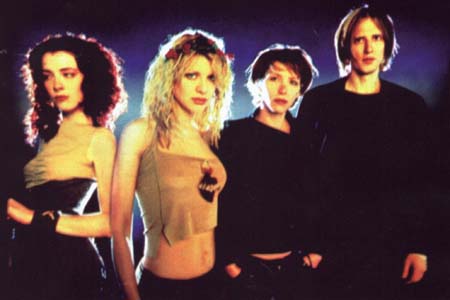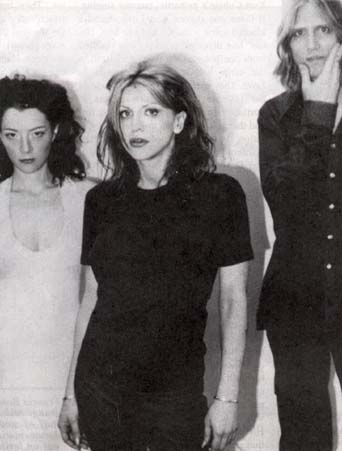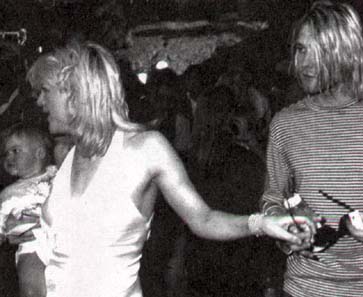Circus 1998 Article
A SONGSTRESS OF
MANY MOODS
COURTNEY
LOVE
BY EDWARD FRUCHTMAN
Within a mere decade, Courtney Love has worn many hats – the fury-fueled feminist songstress, riot-grrrl rocker, temperamental paparazzi-beater, and most recently, fashionable, Oscar-nominated actress. That’s why the overt sweetness in her voice on her band, Hole’s latest and too long-awaited album (Geffen) is deceptive. "You want a part of me/I’m not selling cheap," whispers Love on the title track on Celebrity Skin. It seems we’ve been exposed to every possible facet of Love’s life – a privilege rarely shared by other popular figures.

Very few celebrities get the love ‘em-or-hate- ‘em response more than Courtney Love. She’s received raves for Hole’s jagged rock and her portrayal in 1996 as the drug-addicted wife of Hustler owner Larry Flynt in "The People Vs. Larry Flynt. But it was her two-year-long marriage to late Nirvana guitarist and vocalist Kurt Cobain that made her a major staple, usually negative, in gossip columns and features (it was believed in some quarters that she married him for his money). Plus, she has been volatile in public – striking fans, photographers, hurling four-letter words at targets like her estranged father Hank Harrison and ex-boyfriend Trent Reznor of Nine Inch Nails on the Internet. Thus we have one of the most controversial popular figures in the ‘90s – even rivaling Madonna, who was quite eager to sign Hole to her Maverick Records before they were scooped up by Nirvana’s label, Geffen.
However Love strays far from the bitchy image she once cultivated. A picture on the cover of the import-only 1997 compilation, My Body, The Hand Grenade, features one of Love’s trademark Raggedy Ann dresses encased in a museum glass display. Whether she’s giving up this persona or sounding a false alarm is not known. But there are some clues to the former.
Despite various past unsuccessful attempts, she enrolled in drug rehab (through her constant companion, Edward Norton’s urging) and by her admission, is now totally clean. She’s even become polite, for the most part. During an appearance on NBC’s "Today Show," she refused to comment on her past drug use because of the series’ "demographic." When prodded, she silently walked off the set. This was a far cry from a year earlier, when she had a screaming, expletive-filled fit in Amsterdam after a bunch of hecklers shouted "You killed Kurt!", and then stormed offstage.
The 32 year-old guitarist even had an image makeover to mark this renewal. Once a staunch devotee of wearing baby-doll dresses and scrolling the words "slut" and "bitch" on her arms (the so-called "kinderwhore" look, also adopted by Kat Bjalland of Babes In Toyland), Love is now Tinseltown with her Versace gowns, yoga-trimmed figure, carefully coiffed styles and high heels. Her "celebrity" skin may be torn a bit, but for the large part, she’s weathered many a publicity storm. With her Harpers Bazaar-friendly appearance, she barely looks at it. "My feminist upbringing taught me that pretty was passive," she told US Magazine last year, explaining her new attitude. "But sometimes it’s fun to be the angel on top of the tree for five minutes. I’ve been afraid to be pretty, but not so much anymore."
Never has Love sounded more at peace with herself on Celebrity Skin. Its 12 tracks are filled with references to death, the fading away of love (Love?) and low self-esteem. But these tracks have a sunny edge that her past material barely had; she offers peaceful solutions rather than those exhorting anger. In "Malibu," she encourages her lover not to "lay down and die," but to escort her to that famed recreational area. At other times, Love looks up to the stars for guidance and relaxation, as in "Northern Star." This turnaround can be symbolized by her insertion of the logo of the Los Angeles’ Department of Water and Power (a picture of the landmark, including its "water wealth contentment health" slogan is in the album booklet). Her trademark cynicism is still there, but lurking further in this more listener-friendly soundscape.
Similarities to ‘70s era West Coast band trademarks like the Eagles harmonies and rich production values of Fleetwood Mac abound, and they fare well for Hole. But despite the brilliance of guitarist Eric Erlandson’s tasteful riffing, bassist Melissa Auf der Maur’s sweet harmonies and temporarily-exited drummer Patty Schemel’s forceful beats, Love shines the brightest here. Aside from her occasionally long drawn out biting of words, Love embodies the pleading, delicate vocals of her idol Stevie Nicks rather than the hoarse, primal yells of Patti Smith, as she’s done for most of her singing career. "I almost want to make the cover a big picture of a Douglas fur getting rained on," she said in the same interview. "It’s about the denial of death. Go to the light."
It seems she’s evolved from the erratic grunge icon to uber-pop vixen, with many growing pains. Even before her multi-platinum selling status or Oscar-nominated name, Love has always stood out since her sad, confused childhood. Born Love Michelle Harrison in San Francisco on July 9, 1965, she was very introverted girl who kept to herself. Her hippie parents - a Grateful Dead friend/biographer and a therapist mother - divorced when she was four years old, and she became the focus of a bitter custody battle.
Linda won the right to raise her daughter, but little Love was miserable. Every time her mother wed, little Courtney (who was renamed by her mother after one of her friends) was always on the move and changing last names. They stayed in Oregon and at different times, in New Zealand. At the commune, located in Marcola, Oregon, the other girls teased and calling her "Pee Girl" because her clothes were never washed (a phrase which was immortalized on "Softer, Softest" on ‘94’s Live Through This). According to her mother, Courtney used to have many nightmares in Portland and visited the therapist regularly. According to a biography by Poppy Z. Brite, she even drew "wounded figures" and hateful crayon drawings of her younger half-sisters.

Love became an active rebel in her early teens. When she was about 13, she was caught shoplifting a Kiss T-shirt from a local Woolworth’s in Portland. Since then, she was ordered to go from one foster and juvenile delinquency home or reform school to the next. Her file of delinquencies thickened at this point, including reports of pot-smoking, chain smoking and throwing temper tantrums. When she went to stay with one of her parents, they reportedly told her to leave and board with the other one. Musically, she always had good and plentiful company; she surrounded herself with the mellow nuances of favorites like Leonard Cohen, Stevie Nicks and Joan Baez growing up and by her late teens, her world was full-throttle everything, including the brash often-tuneless chaos of Sonic Youth, British-oriented punk and goth.
Later on, she spent her time hitchhiking, dancing as a stripper inlocal Portland clubs and hanging out at the local disco. Privileged to receive $500 trust fund per month, she decided to take off and see the world. Along with a tight clique of like-minded peers, she traveled to England, Ireland, and Japan.
Love had one solution to make people notice her and take her seriously: rock ‘n’ roll superstardom. With several close friends she played in informal bands. Her punk, unconventional roots were sown quite early: as a teen, she was well-read in literature, especially Walt Whitman and the classic French surrealist works of Baudelaire. She teamed up with her good friend Robin Barbur in a band called Sugar Babylon, and when that didn’t work out, she wrote a column for the cool punk zine "Maximumrockandroll" and even attended Portland State University for awhile (pursuing a prospective philosophy degree).
Aside from music, the always ambitious Love busied herself in other arts. She continued her professional career as a stripper in San Francisco and on the Sunset Strip, played bit parts in movies like the true-life documentary "Sid And Nancy" (1986) and it’s follow-up, "Straight To Hell." A later version of Sugar Babylon, this time called Sugar Baby Doll, featured good friends Bjelland and Jennifer Finch (later of L7). When she was the lead singer for the Cali funk metal outfit Faith No More for a couple of months, Love was heralded compared to the tepid response to the band.
Here, the Hole chapter of her life unfolds. Originally titled Sweet Baby Crystal Powered By God, Hole changed to the present moniker after an idea in the Greek mythic play "Medea" by Euripides that the titular character had a hole ripped into her soul. In 1989, she hooked up with future Hole guitarist Eric Erlandson, who was then working at Capitol Records. Featuring bassist Jill Emery and drummer Caroline Rue, Hole released the "Retard Girl" EP in 1990. After a few singles generated buzz like "Dicknail" and "Teenage Whore," Hole released their angry debut, Pretty On The Inside (Caroline, 1991). The album, voted the best of the year by New York’s Village Voice, was a strong statement of feminism at the time. Love expressed herself through fierce tracks like "Babydoll," "Teenage Whore" and "Goodsister-Bad Sister."
At the same time as Pretty On The Inside was released in the fall of 1991, another album reaching the shops was critically regarded: Nirvana’s Nevermind. Like Pretty, Nevermind was alienating and yet pulled listeners in with its punk derived energy and vocalist/songwriter Kurt Cobain’s cathartic, raucous singing. If there was anyone who Love shared a kindred spirit with, it had to be him. He, too, had divorced parents, was shuffled from place to the next, socialized in the same Seattle-Olympia crowds as Love. They met during a show by one of her favorite bands, Dharma Buns in Portland (for whom Nirvana were opening for) and though they had an awkward conversation, a bond was formed. Soon she insistently began calling Nirvana drummer Dave Grohl to try and get Kurt interested in her.
The determination paid off and before long, Kurt and Courtney hit it off. After the two married secretly in Waikiki, Hawaii in 1992, their daughter, Frances Bean was born that summer. Unfortunately, the bond drew the most heat when Vanity Fair printed a scathing article about Love’s alleged drug taking during her pregnancy. Soon after, the Administration of Children’s Services threatened to take away their baby because of allegations that they, particularly Love, were too unfit to take care of Frances. The episode was traumatic for the couple and especially Love, who still vents about its writer, Lynn Hirschberg and the editor of the magazine at the time, Tina Brown.
Perhaps the darkest aspect of Love’s superstardom surrounds the circumstances of Cobain’s death in April 1994. It’s been alleged in the infamous Mike Bloomfield-directed "Kurt And Courtney" documentary that she was somehow involved in setting up his death at their mansion in Seattle. It demonstrates the astounding media attention she gets and of course, the massive influence that Kurt Cobain still holds in popular culture. When her bassist Kristen Pfaff died from a heroin overdose in her bathtub after the released of their next album, Live Through This, it felt that Love’s material reflected the darkness of death.

Released a week after Kurt’s demist, Hole’s breakthrough full-length effort and major label debut, Live Through This was unveiled in a shadowy sadness. Tunes like "Violet," "Doll Parts" and "Miss World" echoed the confusion and grief of Cobain’s most ardent followers.
The album was slow in sales at first, but ended up earning multi-platinum status. They headlined Lollapalooza ’95, which ended up being quite controversial. On the first day, she had a vicious brawl with Bikini Kill singer Kathleen Hanna (who later filed assault charges). At another show, Love walked offstage when a fan tossed a shotgun shell onstage. But of course, Hole had its cynics. Later is was suspected that the Hole tunes were co-written by an invisible partner in Cobain. Even in ’97, the ex-members of Nirvana themselves challenged the copyrights of a sole Love credit for the B-side "Old Age," included on the My Body, The Hand Grenade collection. She received similar criticism this year when it was revealed that Smashing Pumpkins’ Billy Corgan (reported to be a former flame) co-wrote five songs on the new album.
Love is one of the most misunderstood female celebrities of our time. This type of suspicion must encourage her to become the self-proclaimed "militant feminist" – to assert herself even more so in the male-dominated rock music world. Aside from closure, Courtney wanted everyone to know she was a different person when she sold the Seattle mansion last year, which was becoming a staple on the neighborhood nostalgia tours. As her band heads out on the road in January 1999, one wonders whether she will shed this new persona for another. It doesn’t matter; Love will continue to invite curiousity and arouse a rabid following because of the passion she represents.
Email: frankie_82@yahoo.com




